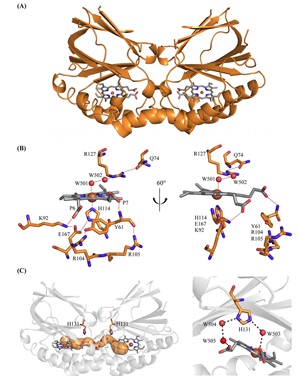Structural and mechanistic studies on chlorite dismutase (Cld) from Cyanothece sp. PCC7425
PRINCIPAL INVESTIGATOR: CHRISTIAN OBINGER
Background.
Chlorite dismutases (Cld) are heme b containing enzymes which were discovered in chlorate- and perchlorate-reducing bacteria (van Ginkel et al., 1996) but are found in many other bacterial and archaeal phyla (Maixner et al., 2008). Reduction of (per)chlorate leads to generation of chlorite, which is a strong oxidant and has cell-damaging effects. The metalloenzyme Cld protects the organism from the accumulation of harmful chlorite by degrading it to chloride and dioxygen (van Ginkel et al., 1996). This catalytic function turns Cld into a highly interesting enzyme for bioremediation as the serious environmental pollutants chlorate and chlorite are used as bleaching agents in the textile, pulp and paper industries, as disinfectants, in pesticides etc. Additionally, Cld is extremely interesting from a biochemical point of view as it is the only known enzyme system which efficiently catalyzes O-O bond formation beside photosystem II. However, the catalytic mechanism of chlorite degradation and its redox intermediations as well as the O2 formation by Cld is not fully understood yet (Schaffner et al., 2017, Lee et al., 2008). Moreover, the enzymatic activities and physiological roles of the vast majority of the structural superfamily are completely unknown. There seems to be an unexpected broad structural and functional diversity of these metalloproteins that is not understood yet (Zámocký et al., 2015). Understanding these differences and the clarification of underlying reaction mechanism(s) are prerequisites for a successful application in biotechnology.
For this reason, a dimeric Cld from the cyanobacterium Cyanothece sp. PCC7425 was chosen and will be comprehensively investigated to gain further insight into evolution and the intrinsic biological function of these highly interesting enzymes. The focus of research will be the mechanistic investigation of the chlorite degradation reaction. Two pathways have been postulated, one involving Compound I and hypochlorite formation and the other involving Compound II and chlorine monoxide formation. We aim at understanding the structural peculiarities that have functional impact to the catalytic reactions and are responsible for the observed differences between Clade 1 (i.e. pentameric) and Clade 2 (i.e. dimeric) Clds. Additionally, the pH dependency of the reaction with chlorite, the protonation status of catalytically relevant amino acid side chains, and the inhibition reaction are unsolved questions that need to be addressed.

Aims and methods.
A number of variants of dimeric CCld will be created, using site-directed mutagenesis, targeting residues involved in substrate binding or in hydrogen bonding networks around the heme cofactor and the interface of the dimer. Target proteins will be expressed in E. coli, also as fully deuterated protein (in cooperation with the Institute Laue-Langevin in Grenoble).
Wild-type and mutant proteins will be characterized by a broad set of biochemical/physical methods including (i) X-ray crystallography (in close cooperation with Kristina DJINOVIC-CARUGO from the Department for Structural and Computational Biology, Max F. Perutz Laboratories, University of Vienna), (ii) neutron crystallography (in cooperation with Leighton COATES, Oak Ridge National Laboratories, and Tobias SCHRADER, Jülich Centre for Neutron Science), (iii) detailed spectral analysis (UV-Vis, electron paramagnetic resonance and resonance Raman spectroscopy) of proteins, and protein-based radicals in different redox- and spin-states (in cooperation with Sabine VAN DOORSLAER from the Department of Physics, University of Antwerp, and Giulietta SMUELVICH from Department of Chemistry, Universitá di Firenze), (iv) time-resoved multi-mixing UV-Vis stopped-flow studies in order to analyse the kinetics of interconversion and spectroscopic features of relevant redox intermediates, (v) spectroelectrochemical studies (in cooperation with Gianantonio BATTISTUZZI from the Department of Chemistry, University of Modena and Reggio Emilia, Italy).
Classical and ab initio molecular dynamics simulations (in cooperation with OOSTENBRINK) will provide valuable insight into the dynamics of interactions of the substrate with the ferric enzyme and of the postulated intermediate with possible reaction intermediates (Compound I vs. Compound II) to expand theoretical models based on new experimental results and previous computational findings (Sündermann et al., 2014).
Lee, A.Q., Streit, B.R., Zdilla, M.J., Abu-Omar, M.M., and DuBois, J.L. (2008) Mechanism of and exquisite selectivity for O-O bond formation by the heme-dependent chlorite dismutase. Proc. Natl. Acad. Sci. U S A 105: 15654-15659.
Maixner, F., Wagner, M., Lücker, S., Pelletier, E., Schmitz-Esser, S., Hace, K., Spieck, E., Konrat, R., Le Paslier, D., and Daims, H. (2008) Environmental genomics reveals a functional chlorite dismutase in the nitrite-oxidizing bacterium 'Candidatus Nitrospira defluvii'. Environ. Microbiol. 10: 3043-3056.
Schaffner, I., Mlynek, G., Flego, N., Puehringer, D., Libiseller-Egger, J., Coates, L., Hofbauer, S., Bellei, M., Furtmueller, P.G., Battistuzzi, G., Smulevich, G., Djinovic-Carugo, K., and Obinger, C. (2017) Molecular Mechanism of Enzymatic Chlorite Detoxification: Insights from Structural and Kinetic Studies. ACS Catalysis 7: 7962-7976.
Sündermann, A., Reif, M.M., Hofbauer, S., Obinger, C., and Oostenbrink, C. (2014) Investigation of ion binding in chlorite dismutases by means of molecular dynamics simulations. Biochemistry 53: 4869-4879.
van Ginkel, C.G., Rikken, G.B., Kroon, A.G., and Kengen, S.W. (1996) Purification and characterization of chlorite dismutase: a novel oxygen-generating enzyme. Arch. Microbiol. 166: 321-326.
Zámocký, M., Hofbauer, S., Schaffner, I., Gasselhuber, B., Nicolussi, A., Soudi, M., Pirker, K.F., Furtmüller, P.G., and Obinger, C. (2015) Independent evolution of four heme peroxidase superfamilies. Arch. Biochem. Biophys. 574: 108-119.
